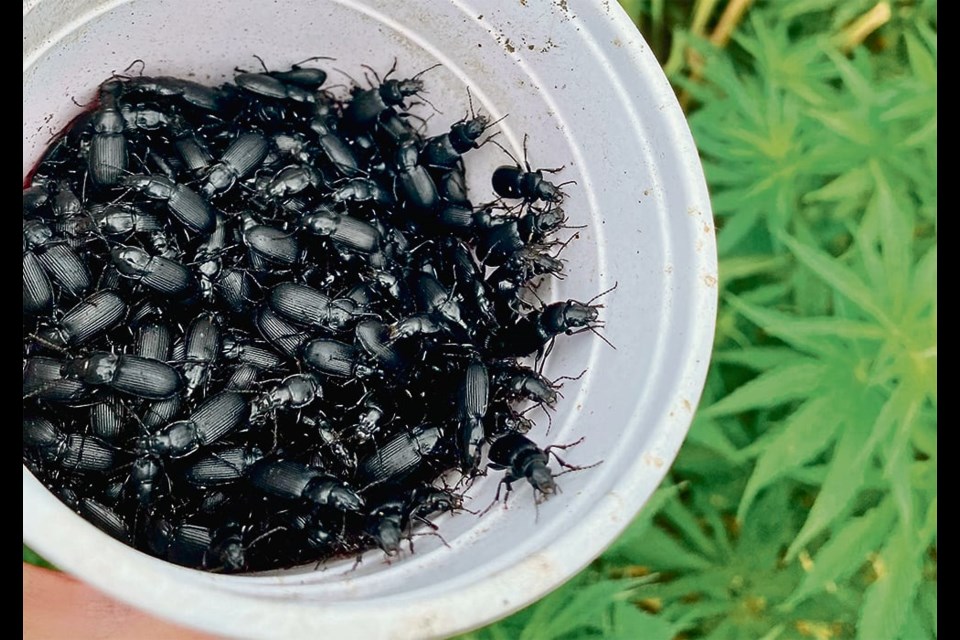WESTERN PRODUCER — Beetles scurry along the soil and among the crops, eating other insects as they go. These shiny black bugs have a role to play in pest control.
Boyd Mori has been studying the DNA of what is found in the digestive tracts of the species Pterostichus melanarius, commonly known as the rain beetle, to better understand what they eat.
Mori is the Natural Sciences and Engineering Research Council of Canada Industrial Research Chair in agricultural entomology at the University of Alberta.
The rain beetle is an invasive species to North America but it’s considered to be a beneficial insect. Although it’s the dominant ground beetle in central Alberta, it doesn’t seem to be out-competing native ground beetles.
Since the summer of 2021, Mori and his team of graduate students have been surveying areas in central Alberta to get a sense of where the rain beetles live, their preferred food items and what crops they are drawn to.
Studying the contents of the beetles’ guts looks to be key to figuring out what the rain beetle eats. At that point in the beetles’ digestion, the only way to see what has passed through is with DNA sequencing.
“We’ve started developing very specific primer sets to basically be able to identify the DNA from specific species,” says Mori. So far his team has been able to identify the DNA of pub weevil and hopes to expand from there to include flea beetles, lygus bugs, diamondback moths, and armyworms.
Given that most crops are in rotation, it has been difficult to tell which crops attract larger populations of rain beetles. Also, since the study is in the preliminary stages, Mori says, “The thing is we don’t really know what’s a good number…. We just don’t have that data.”
To collect the samples, researchers use pitfall traps, which are cups dug into the ground. The opening of the cup is level with the ground and ground beetles fall in. The researchers count the number of beetles in the cup.
However, because the study is still new, determining what constitutes a healthy number of rain beetles for one area is unclear.
Rain beetles may also be eating weed and grain seeds. Another study is being carried out through collaboration with the University of Saskatchewan to see if the bugs have an omnivorous diet.
Other than the use of insecticides, climate is one of the biggest factors that can affect these beetles.
“… in our work over the past few summers, we’ve definitely seen some big peaks and valleys of different ground beetle populations, especially with Pterostichus melanarius. Under the heat of 2021, we saw huge explosive numbers…. Last summer in 2022, it was very much reduced,” says Mori.
Farmers can help maintain healthy biodiverse populations by keeping pieces of their fields intact. This could be margins around fields, natural sloughs, hedgerows, or intentionally created non-cropped areas that can serve as refuges for beetles, pollinators and birds. These fringe areas give spaces where species can breed and overwinter before they move out into the fields.
“Some (rain beetles) are scavengers, so they will help in decomposition of other dead, decaying organisms in the field.”
Mori says the beetles also help with pest management and nutrient cycling.
“They could, of course, also be prey items for birds and other wildlife… helping to support that biodiversity there…,” Mori says.
When the beetle gut DNA sequencing study has results to share, the information will be made available.
“I don’t do this in isolation. I have a really good group of graduate students who are doing this work. They are definitely the manpower and some of the brains behind all of this.”
The work is funded by the Natural Sciences and Engineering Research Council of Canada Industrial Research Chair, Canola Council of Canada and Western Grains Research Foundation.
In the future, Mori would like samples from more regions including northern Alberta. As the primer sets are developed to identify specific DNA of prey species, he would also like to expand the study to include other prey invertebrates, such as spiders.



